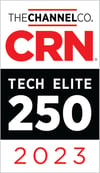Recent acts of cyberterrorism have underscored the importance of raising your company’s IT security game. CNN reported a notable rise in cyberattacks, citing that in May 2021, hackers targeted the Colonial Pipeline, which supplies gas to the east coast of the U.S., and the food processor JBS USA, threatening the nation’s vital fuel and food supplies.
These large companies are not the only ones that need to worry. Any type of business can become a victim of cybercrime.Heightened security risks require that organizations rethink their approach to IT security to gain greater visibility into threats, as well as the ability to predict and prevent attacks. One novel approach is that of software-defined security (SDSec).
Like other forms of software-defined technology, SDSec uses software to separate critical functions from the hardware layer, optimizing visibility and control. SDSec brings many security capabilities to the table so that companies have the power to defend against today’s advanced threats.
How to Achieve Software-Defined Security
To achieve SDSec, your company must abstract your security functions from the hardware. Abstraction allows security functions to operate across the IT environment, protecting on-premises resources, endpoints, and public or hybrid cloud infrastructure. SDSec takes advantage of the software-defined network (SDN), so implementing SDN can be the first step to deploying SDSec.
Security functions, such as firewalls and access and authentication controls, need to be virtualized to protect an increasingly virtualized infrastructure. With SDSec, these security tools become virtual network functions (VNFs), which can run as software on commodity hardware.
SDSec functions through automation and orchestration. Security and compliance operate independently of human intervention. Policies for access, authentication, and intrusion detection can be set and activated across the entire IT environment.
Orchestration means that, with SDSec, your company takes a holistic and integrated approach to security. Security requirements are aligned, and multiple control systems can be deployed across applications and infrastructure environments.
Features of Software-Defined Security
SDSec embraces the concept of zero-trust security, which is defined as never trust, always verify. SDSec has key features that control access to data and applications across the IT environment while also detecting and identifying threats.
Visibility
Centralized management allows for complete visibility into all aspects of the IT infrastructure, including endpoints. Analytics identify and classify devices and users.
Segmentation
Network segmentation makes it possible to set different access policies for complex network configurations that support many devices and users.
Analysis
Analytics include machine learning capabilities for intelligent intrusion detection and prevention across the network.
Automatic Scalability
Security and compliance controls can scale automatically as compute resources change.
Software-Defined Security Solutions
Some of the leading technology companies offer SDSec solutions. Working with one of their partners will ensure that your company successfully transitions to SDSec.
Cisco
Cisco Software-Defined Access (SD-Access) automates user access and accomplishes end-to-end network segmentation.
Dell EMC
Dell EMC provides SDN, which allows workloads to be supported by their own network, where they can be segmented and protected from intrusions.
IBM
IBM takes a cognitive approach to SDSec, using artificial intelligence to identify vulnerabilities and suspicious activity.
VMware
VMware delivers SDSec as part of its software-defined data center (SDDC) solution, providing security and control for all your data and applications.
Software-Defined Security Goals
Cisco’s 2021 Security Outcomes Study found that the top 3 practices associated with the success of a security program were a proactive technology refresh, integration, and a sound security strategy. SDSec delivers on all 3 goals with its software-defined architecture and end-to-end approach.
ProActive Solutions can help ensure your company achieves SDSec through our data center transformation offerings, which include a full range of software-defined solutions. We partner with leaders in software-defined technology to give your company strong options for implementing software-defined storage, network, and data center.
Explore other software-defined technologies. Read our eBook The Complete Guide to Software-Defined Everything.



